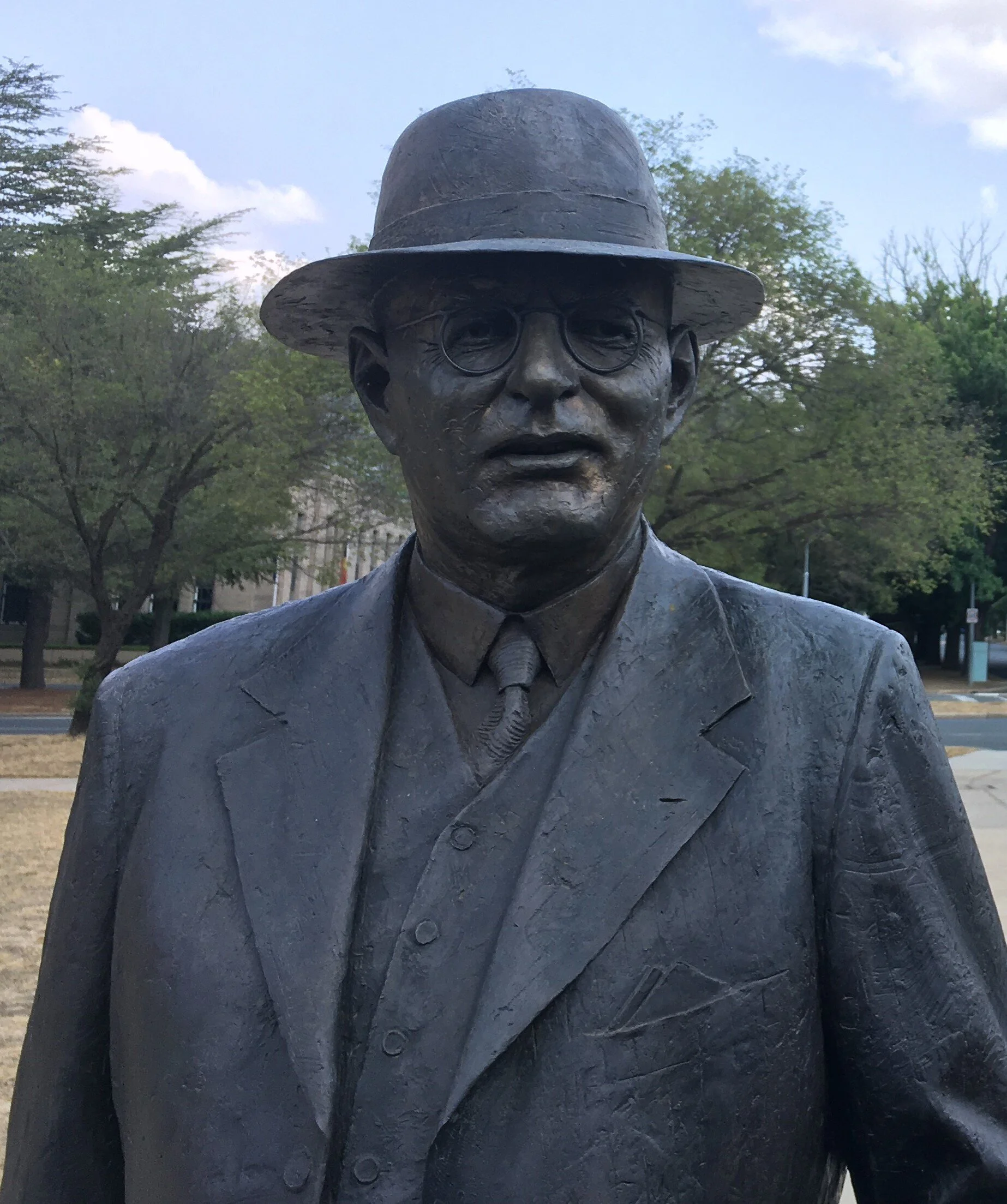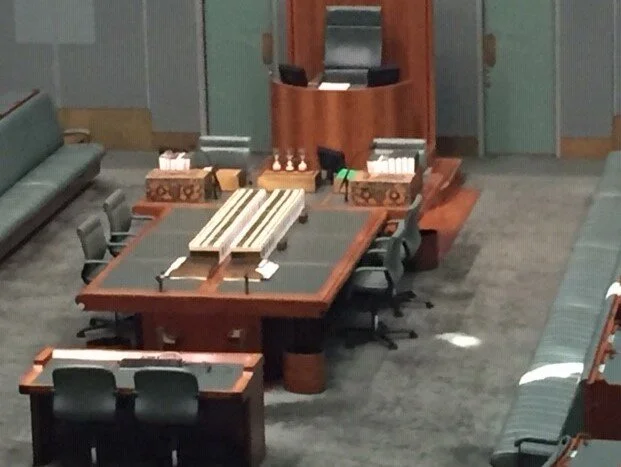No. 5 Flag mast of Parliament House, Canberra 100
Canberra 100
In 2020 Capital history here is exploring Canberra’s history by identifying objects that can connect us with Canberra’s past. The end goal is to find 100 objects that can tell us the story of Canberra. Four objects have been identified so far: the Canberra red brick; the Cummings concrete bus shelter; the Bronze sculpture of Prime Minister John Curtin; and the Monaro Mall logo sign.
The flag mast of Parliament House
The flag mast of Parliament House is No 5 in the Canberra 100 series.
Rising above Parliament House the flag mast has been a constant feature of the Canberra skyline since the opening of the new Parliament House in 1988. The image above shows it breaking through the smoke haze which blanketed the city over the 2019-20 Summer holiday period.
It is enormous. One of the largest stainless-steel structures in the world. Constructed from polished Newcastle steel, it is 81 metres tall and weighs 220 tonnes. The flag it bares is about the size of the side of a double-decker bus.
In Australia in the 1980’s everything was big so Parliament House’s excessive flag mast seems very much of its time. The building was opened by the Queen on 9 May 1988 during Australia’s extravagant bicentenary celebrations. It was Australia’s long overdue permanent Parliament House replacing what was the transitional Parliament House and now the Museum of Australian Democracy at Old Parliament House.
Designing a National Parliament
In 1978 the Fraser Government decided to build a permanent Parliament House, ready for Australia Day 1988, the bicentennial year of European settlement. The Parliament House Construction Authority was established to manage the immense project. A two-stage design competition was held with competitors guided by a design brief and guidelines. Stage One attracted 329 entries from 28 countries.
On 26 June 1980 it was announced that New York-based architectural company Mitchell/Giurgola & Thorp had won Stage Two. They were responsible for the design conception, sitting and architecture, as well as the interior design, furniture design, landscape, and coordination of the art and craft program. Romaldo Giurgola AO headed up the team that moved to Canberra from the firm’s New York office to deliver the project. He along with four of the team stayed in Australia after their work was done. You can read his account of the project here.
Besides the 1980’s the monumental flag mast was in line with the brief which guided the winning designers. It asked for a building that would be a major national symbol, as readily recognisable as the spires of Westminster or Washington's Capitol dome. But it highlighted that while the building must be symbolically powerful as a national Parliament it was crucial careful consideration was given to the scale and monumentality of the design.
Designers also had to be mindful of Walter Burley Griffin’s 1912 original plan for Canberra that placed the most significant national building at the apex of the parliamentary triangle, the centrepiece of the capital. The assessment of the winning design noted that the marking of the apex with the flag mast successfully met this aspect of the design brief:
Like Griffin's plan, the winning design is a building of firm, clear geometry, not rigidly imposed on the terrain but sensitively adjusted to it. This design is not a monumental structure superimposed on the Hill. It derives its strong presence by merging built form with landform. The successful synthesis of these two essential elements has resulted in a design that is at once natural and monumental…
The building form visually extends these views beyond to the distant landscape, perpetuating the Griffin ideal of the domination of landform.
The winning design does nonetheless recognise the fact that the Capital Hill site has an apex, and one that demands some reinforcement if the design scheme is to ultimately succeed. The more or less transparent mast structure supporting the National Flag is a simple and imaginative solution to achieve the visual climax required. This marking of the apex of Capital Hill successfully fulfils the intent and purpose of the original Canberra plan.
In addition the flag mast marks the exact centre of Parliament House and the intersection between the building's 'law-making axis', on which the House of Representatives and Senate chambers are located, and its 'land axis', which runs from the forecourt and contains the key public areas of the building. With this design the elements of the Australian democracy are symbolised —the people, the parliament, and the government—and are all together under the national flag.
A national and city symbol realised
The Canberra Times marked the opening of Parliament House with a 48 page Souvenir supplement, and even at this starting point it was reported that the flag mast atop of Parliament House had become an instantly recognisable national symbol.
Twenty five years later the Royal Australian Mint in celebrating Parliament House’s anniversary took inspiration from the flag mast to mint Australia’s first triangular coin. The triangular $5 silver depicts Parliament House as viewed from one of its courtyards with the distinctive triangular flag mast the focal point of the design.
The flag mast has become one of Canberra’s most recognisable sights and the accepted and, possibly at times inspiring, symbol of our national parliament. It is also pleasing that it connects Canberrans’ back to Walter Burley Griffin’s 1912 original plans for his ideal city and stands as a worthy tribute to the architectural mastery of Romaldo Giurgola AO.
If you have comments on No. 5 Flag mast of Parliament House and Canberra 100 please provide to mail@capitalhistoryhere.com. Also let me know if you have suggestions for objects that should be included in the Canberra 100 series?
And please share. Let’s get the past and present talking.
References
Newspapers
1988, The Canberra Times (ACT: 1926 - 1995), 9 May, p. 1. (SUPPLEMENT TO THE CANBERRA TIMES), viewed 15 May 2020, http://nla.gov.au/nla.news-page12747805
Other
Australia. Parliament House Construction Authority. & Australia. Parliament House Construction Authority. 1980, Parliament House design competition : report by Construction Authority on winner's design, July 1980 the Authority Canberra https://nla.gov.au/nla.obj-1928639597, viewed 15 May 2020
Andrew Hutson 2011, Square Peg in a Square Hole: Australia’s Parliament House, Papers on Parliament No. 55, Parliament of Australia, https://www.aph.gov.au/About_Parliament/Senate/Powers_practice_n_procedures/~/~/link.aspx?_id=A1D49E705C904AEA927BD4BE95E2FE11&_z=z, viewed 15 May 2020
McCann, J, Hough A, Heriot, D, 2018, The 30th anniversary of Australia’s Parliament House, Parliament of Australia, https://www.aph.gov.au/25th_Anniversary_Chronology, viewed 15 May 2020
Micheli, S, 2016, Vale Romaldo Giurgola AO, 1920–2016, Architecture Australia, https://architectureau.com/articles/vale-romaldo-giurgola-ao-19202016/, viewed 15 May 2020
National Capital Authority, Parliament House, Fact Sheets, https://www.nca.gov.au/parliament-house, viewed 15 May 2020
National Film and Sound Archive, Australia in the 1980s, https://www.nfsa.gov.au/collection/curated/1980s, viewed 15 May 2020
Parliament of Australia, Learn about the flag, https://www.aph.gov.au/Visit_Parliament/Things_to_Do/Learn_about_the_flag, viewed 15 May 2020
Peter Harrison, 'Griffin, Walter Burley (1876–1937)', Australian Dictionary of Biography, National Centre of Biography, Australian National University, http://adb.anu.edu.au/biography/griffin-walter-burley-443/text11115,
published first in hardcopy 1983, viewed 15 May 2020
Royal Australian Mint, Australia's first triangular coin marks Parliament House's quarter of a century, https://www.ramint.gov.au/publications/australias-first-triangular-coin-marks-parliament-houses-quarter-century, viewed 15 May 2020





